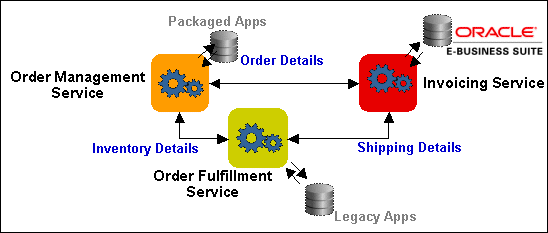Oracle E-Business Suite Integrated SOA Gateway is a complete set of service infrastructure. It supports almost all integration interface types and services invoked within Oracle E-Business Suites no matter if they are Oracle seeded integration interfaces or custom ones, if they are native packaged interfaces or the services that are orchestrated using native services.
With this pre-built, reusable business services and service-oriented components, Oracle E-Business Suite Integrated SOA Gateway provides a capability of allowing various users to perform different tasks and to monitor and manage service integration throughout the entire service deployment life cycle.
Major Features
Oracle E-Business Suite Integrated SOA Gateway contains the following features:
- Provide robust, consistent integration framework with extensive infrastructure based on SOA principles
- Integrate loosely coupled and heterogeneous applications
- Contain pre-built and reusable business services
- Provide native service enablement capability within the Oracle E-Business Suite
- Use native services as building blocks to create composite services
- Support annotated custom integration interfaces from Oracle Integration Repository
- Enforce function security and role-based access control security to allow only authorized users to execute administrative functions
- Support multiple authentication types for inbound service requests in securing Web service content and authenticating Web service operations
- Provide centralized, user-friendly user interface for logging configuration
- Enable Web service invocation from Oracle E-Business Suite
- Audit and monitor Oracle E-Business Suite service operations from native SOA Monitor
Business Process Scenario
Oracle E-Business Suite Integrated SOA Gateway provides a seamless integration between various applications. Take the most common business process such as Order-to-Receipt as an example to further explain how discrete web services can be orchestrated into a standards-based manner and more meaningful end-to-end business flow.
Order-to-Receipt Business Flow Between Applications
The packaged application is used to capture the order. The legacy application is used to fulfill (pick and ship) the order. Oracle E-Business Suite is used to invoice the customer.
- Sales Order Entry: Packaged Application
- Item Availability Check: Legacy Application
- Pick, Pack and Ship : Legacy Application
- Invoicing and A/R: Oracle E-Business Suite
A complete Order-to-Receipt business flow may require to integrate with each of the above applications at different points. With Oracle E-Business Suite Integrated SOA Gateway, the public integration interfaces of E-Business Suite can be exposed as standard Web services.
Each individual business process mentioned here managed by packaged application, legacy application, and Oracle E-Business Suite can be orchestrated using Oracle BPEL Process Manger (PM) to streamline the Order-to-Receipt business process.
Process Integration Within Oracle E-Business Suite Integrated SOA Gateway
Oracle E-Business Suite Integrated SOA Gateway Architecture Overview
Oracle E-Business Suite Integrated SOA Gateway employs essential key components that enable service integration at design time and run time, and ease the service management throughout the entire service integration and deployment life cycle.
The seamless integration between each component forms the Oracle E-Business Suite Integrated SOA Gateway architecture.
The following diagram illustrates the integration architecture flow between each component:
All the native packaged public integration interfaces are published in the Oracle Integration Repository by default. Integration repository administrators can then transform these native integration interfaces into Web services through service generator. Service loader uploads service artifacts to Oracle Integration Repository. Service deployer deploys service artifacts from the Integration Repository to the application server where services can be exposed to customers through service provider.
Service provider identifies and processes inbound SOAP requests from service consumers, reinforces function security and Web service security, as well as passes all SOAP request and response messages to SOA Monitor (if the monitoring feature is enabled) for further monitoring SOAP messages to ensure the seamless service invocations throughout the entire service life cycle.
For composite services, system integration developers orchestrate composite services using Oracle JDeveloper. Service loader then uploads these service artifacts to Oracle Integration Repository. Users granted with the Download Composite Service privilege can further download the BPEL files to their local directories. Integration repository developers can open the downloaded BPEL files in Oracle JDeveloper, modify and deploy them if needed. Oracle BPEL Process Manager (BPEL PM) or 3rd party J2EE BPEL PM will then pick up deployed composite services which can be invoked from the Oracle E-Business Suite


